Develop an emergency action plan and follow it.
For those who don’t know me, my name is Harvey Bird Jr., and I am the founder and President of the Metropolitan Herpetological Society, a Staten-Island-based reptile club. On October 29, 2012, Hurricane Sandy devastated the lives of so many on the Northeast coast, most notably New Jersey and Staten Island. While I was fortunate enough to not lose my home completely, the destruction caused to it and our neighborhood has served as a reminder of how punishing Mother Nature can be and how precious life really is. I wanted to take the opportunity to share my story because we never thought we would see a natural disaster of that capacity, so the reality is it could happen to anyone.
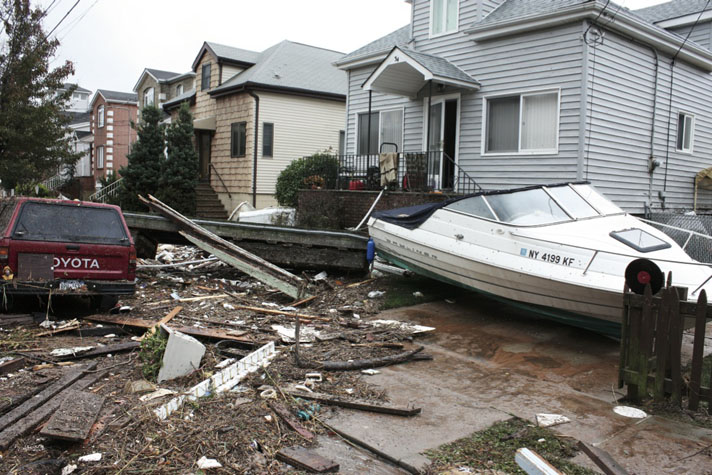
Harvey Bird Jr.
An 18’-foot Bayliner sat across the driveway, still tied to the 20-foot dock.
A Little History
I was born and raised on Staten Island, N.Y. I had the luxury of living in a home about a football field’s length from the shores of Crescent Beach, which sits at the mouth of Great Kills Harbor, part of Raritan Bay. I currently share that home with my wife, 1-year-old twins and my folks.
Most people associate Staten Island with the reality show, Jersey Shore, and the landfill that can be seen from space. Herpers think of Carl Kauffeld and his world-renowned collection of rattlesnakes at the Staten Island Zoo. The reality is that Staten Island is a special place because it offers people a more rural lifestyle in a major city. It is considered the most rural of all of the five boroughs of New York City. There are a total of 9,300 acres of land that have been protected as federal, state and city parks. And despite the consistent increase in development over the years, it still serves as home for approximately two dozen native reptile and amphibian species.
At one time, my neighborhood was mostly woodlands, meadows and coastal wetlands. I was taught at a young age by my parents to appreciate nature and all it had to offer. We would often see box turtles, garter snakes, brown snakes, black racers, Fowler’s toads, diamondback terrapins and even the occasional sea turtle. And whether it was walking down our street with my dad, fishing poles in hand, headed to the beach, or out in my yard on a warm summer night with my mom catching toads, I had really positive experiences with nature as a child.
Over the years, I have kept a variety of reptiles and amphibians, including most of the more common species like corn snakes, blue-tongued skinks, bearded dragons, leopard geckos, various milk snakes, kingsnakes, etc. While in my early 20s, I started to breed corn snakes, African house snakes and pictus geckos.
Today my collection is still very eclectic. I keep and breed a wide variety of herps, and at the same time, I do a lot of outreach programs in the community.
Always Be Prepared For When Disaster Strikes
When people started talking about Hurricane Sandy being on course to hit the Northeast coast, I was quite nervous. Most people shrugged it off, given that hurricane Irene, “the storm of the century” from the previous summer, turned out to be nothing more than a typically moderate tropical storm. Still, I was a bit apprehensive because I had a bad gut feeling about this one.
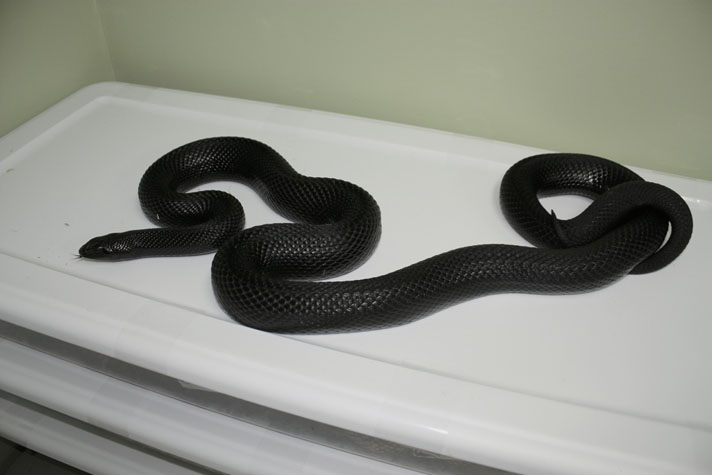
Harvey Bird Jr.
The author planned to move as many of his expensive animals, breeding groups, oldest pets and more care-sensitive species to different locations. Pictured here is a female black pine snake.
I live close to the ocean, and I was worried about what course of action to take with my reptiles. If forced to evacuate due to a bad storm, I would only have time to take a few animals with me. However, at the same time as I was worried, I was also skeptical about moving everything because we had been through tidal surges before, and at the worst, we got a couple inches of water in the basement. I decided to keep tracking the storm and to make a final decision of which animals to move when the storm got closer.
Emergency Preparation Tips
- Prearranged Location Points. Have at least one place you can relocate animals in case of emergency. It is better to have more than one if you have a large collection. (Example: a friend or a relative’s house).
- Develop Emergency Contingency Plan. Have a contingency plan together for just-in-case scenarios. Even if you have never needed one, you can never be too sure when an emergency will arrive, whether it is forecasted or sudden.
- Over-prepare. In case of a severe weather alert, follow your contingency plan because it is better to be prepared for the worst. It is better to relocate animals and have a false alarm, than it is to not follow your plan and be forced to act at the last minute.
- Prioritize Rescue. During a sudden emergency, human safety comes first. If there is any extra time, then worry about saving whatever you can.
- Transporting Animals. If you must relocate your animals, have something around that you can transport them in, such as deli cups, plastic sweater and shoe boxes, Critter Keepers, pillow cases, etc.
- Temporary Enclosures. It may not be possible to relocate your animals and their permanent enclosures. It is helpful to have something that could house your animals comfortably until they can return home.
- Emergency Supply Kit. Have backup supplies, such as heating elements, lighting, water bowls, bedding, towels, etc. Having emergency supplies handy and ready to go make relocating a collection quicker.
- Store Water. During major storms or natural disasters, clean drinking water may not be readily available. Have enough stored for you and your animals.
- Hot Packs/Cold Packs/Water Bottles. Depending on geographic location and season, it may be necessary to keep animals warm or cool. Water bottles can be filled with hot or cold water depending on what your reptile/amphibian needs.
- Emergency Generator. They can be a bit expensive, but if you lose electricity and have nowhere to bring your reptiles, then a generator can run some heating elements to keep your animals comfortable.
By the time Sunday arrived, it was inevitable that Sandy was headed straight toward us. I sent my wife Janine, our twins and our dog, Jake, to her parents’ house. I also decided to start moving some of my collection to locations that were on higher ground. I began to prepare temporary holding containers for my herps. It is difficult to relocate animals and their permanent homes, so I used the additional plastic sweater boxes, shoe boxes and critter keepers that I have on hand for easy transport to and from programs and events.
My plan was to move as many of my most expensive animals, breeding groups, oldest pets and more care-sensitive species to different locations. The rest of the animals I made sure were at least four feet off of the floor. I figured at the worst, we would get a couple of feet of water in the basement. Luckily, I had two locations I was able to bring my animals. I dropped most of my lower-maintenance animals at my in-laws’ house, with the only exception being my uromastyx, which I set up a spare 20-gallon long tank with heat lamps there, as well. My more care-sensitive animals, such as my turtles, 50-pound sulcata tortoise and neonate garter snakes, were relocated to my friend Fred’s house.
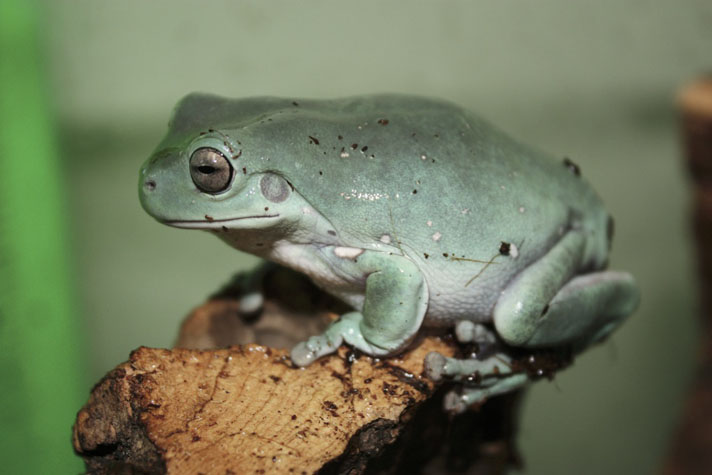
Harvey Bird Jr.
The author’s White’s tree frog did not survive the flood.
At that point, I was as prepared as I could be for the coming storm. Now all that was left to do was wait and see what was going to happen. I had a hard time sleeping that night.
That following morning was intense. Everyone on the block was making last-minute preparations for the storm’s arrival. We had some tidal surge with the initial high tide in the morning, coming as far up the street as our next door neighbor’s house. It didn’t stay long, and receded with the outgoing tide. However, the ocean was rough, as the wind caused waves to slam against the shore, and nothing but white caps were visible as far as the eyes could see.
We settled into our homes and just waited. At 2:30 p.m. the power went out completely. This was a bad omen. We had never lost power during a major storm, and the storm was still hours away. When the ocean was flooding the bottom of our street at 4:30 p.m., we knew we were in major trouble. By 5:30 p.m., the water was starting to cover our grass. We had the generator running in the yard to power the pumps in the basement to stop any flooding.
Not long after the water covered our grass, it started to make its way down our driveway. Before we knew it, ocean water from behind our house was meeting the water in front of our house. It started to enter our basement door. At that point, there was no way we could stop it. I ran down into the basement and brought as many animals up stairs as I could into our living room on the first floor. I got as many as I could upstairs, and left the animals that were up the highest down there.
My best friend, Fred Nattboy, Treasurer of MHS, was there helping me out, and he urged us to leave. It was getting dark, and the wind was extremely violent. It was only a matter of time before the water reached the truck. My parents continually refused to leave. Janine and the twins were by themselves and very scared. I knew she needed me, but I was torn. My father’s health hasn’t been the best, and I knew he could use the help. My emotions ran high, but I knew I needed to leave and be with my wife and children.
I grabbed a bag of clothes, and my buddy grabbed a Rubbermaid tub with my Argentine tegu. We slowly made our way down the porch steps, bracing the wind and descending into the knee-deep, frigid seawater that engulfed my house. Fred stopped to grab something and put the plastic tub down. In a split second, the wind flung it in the air and the tegu splashed into the ice cold water. I screamed in desperation. Miraculously, the current brought him back into my reach. In the midst of the pitch-black darkness, I could see his white beady scales exposed from the surface of the water. I scooped him up, wrapped him in clothing and ran to the truck.
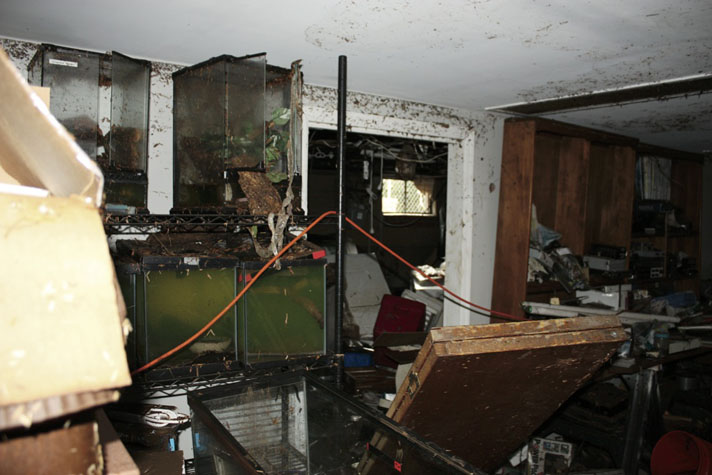
Harvey Bird Jr.
The reptile room in disarray with ruined enclosures.
We made our way to my in-laws’ house. I was hysterical the whole way because I hated leaving my parents and home behind. I was relieved when I received a phone call from my parents an hour later letting me know that they were being evacuated by the Emergency Service Unit of the NYPD.
I barely slept that night. The sounds of the wind howling and constant explosion of transformers in the distance kept me on edge. I couldn’t stop replaying the nightmare of what happened over and over in my head. I forced myself to fall asleep because I knew the sooner I fell asleep, the sooner the morning would come and I could head back to the house.
At 7:30 a.m. on Tuesday morning, Fred picked me up and we went back. A giant old tree was stretched across the street, separating the top of the block from the bottom. Beyond the tree was a mess of debris that covered the entire bottom end of the street. Amongst the debris were boat docks, furniture, driftwood, peoples’ belongings and parts of homes. We made our way down to my house, where a boat sat across the driveway, still tied to a twenty foot dock, someone’s stocked refrigerator on our lawn, and a pile of debris 5 feet high and 20 feet wide in the yard.
I was afraid to go inside. Unlike most of our neighbors, our first floor was still intact. However, our estimate of a couple of feet of water in the basement at worst, was way off. We could tell by the water line and the mud on the steps leading to the basement that our basement had filled with 7 feet of water, from floor to ceiling, and coming all the way to the top step of the stairway to our living room. Although most of the water receded with the outgoing tide, there was still about 2 feet of water in the basement that morning.
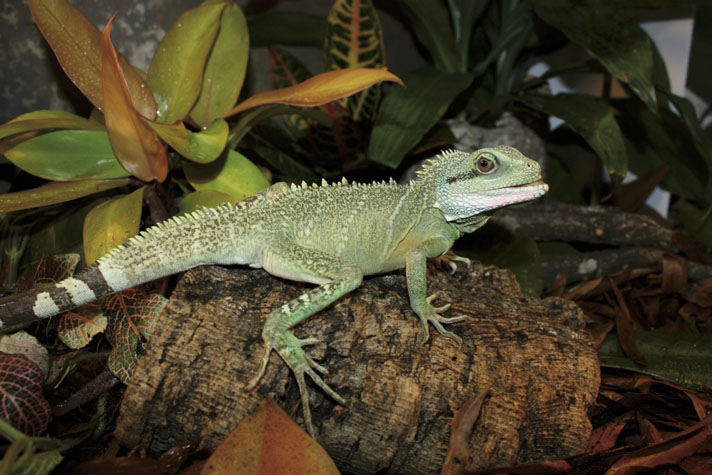
Harvey Bird Jr.
This Chinese water dragon survived spending a night in frigid saltwater.
I was sick to my stomach and couldn’t go down to check. So Fred, being the great friend he is, went down for me. My cages were thrown everywhere. The few animals that were in them were displaced. As he searched with the headlamp, he came across a live snake. My Florida kingsnake was inside its sweater box, half filled with sea water, but still alive. Also found alive were my green water dragon and Australian water dragon, both floating on debris. A few more live snakes were found, but also a good number of dead animals. All of my frogs died, as their tanks filled with salt water, and my bearded dragon and one of my blue-tongued skinks drowned. All in all, out of 23 animals left down there, 10 survived. Later that day, Ron Milo, Vice President of MHS, took my remaining animals in until we were able to finish rebuilding. All of the animals that survived the surge are still doing well since the storm, despite the stress of relocation.
I didn’t have too long to mourn over the animals lost because we got to work cleaning up rather quickly. We had so much help and the support of so many. We are fortunate to have such incredible people in our lives. Fred was there throughout the storm and cleanup, doing everything he could to help. Without him, and all of the people who showed up to help, our morale would be way down. Instead, thanks to those people, our basement and yard were emptied and cleaned in six days. A number of MHS members, such as Ron Milo, Joseph Calvagna, Eugene Briskman and AJ Ferrino, were among those who eagerly showed up to help. We are now in the rebuilding phase. Walking around the storm ravaged neighborhood serves as a reminder to just how strong Mother Nature is and just how precious life is in general. Things may be repaired completely in the next few months, but the image of the damaged homes and lives will always remain. The friendships that were forged and strengthened with people during those days will be remembered for a lifetime. The storm may have destroyed our homes and inconvenienced our lives, but never broke our spirit.
The storm was surreal and a scary experience. But like I tell everyone, it was sort of a blessing in disguise because beyond the devastation, it brought so much good. We got to meet a lot of incredible people and got to build special relationships with neighbors, friends and strangers as we worked together to get through the hardship. There is no guarantee that this will never happen again, but if it does, we know we can persevere, and that includes the animals. Having survived the experience, there are now many steps that are part of my emergency preparation plans (see “Tips for Emergency Preparation” sidebar). Consider making a list of your own so that you are ready if disaster strikes.
Harvey Bird is a physical education teacher from Staten Island, N.Y. He founded the Metropolitan Herpetological Society in January 2006 and serves as President of the group. He is an avid herpetoculturist and field herper, who enjoys photographing reptiles and amphibians in their natural setting.


